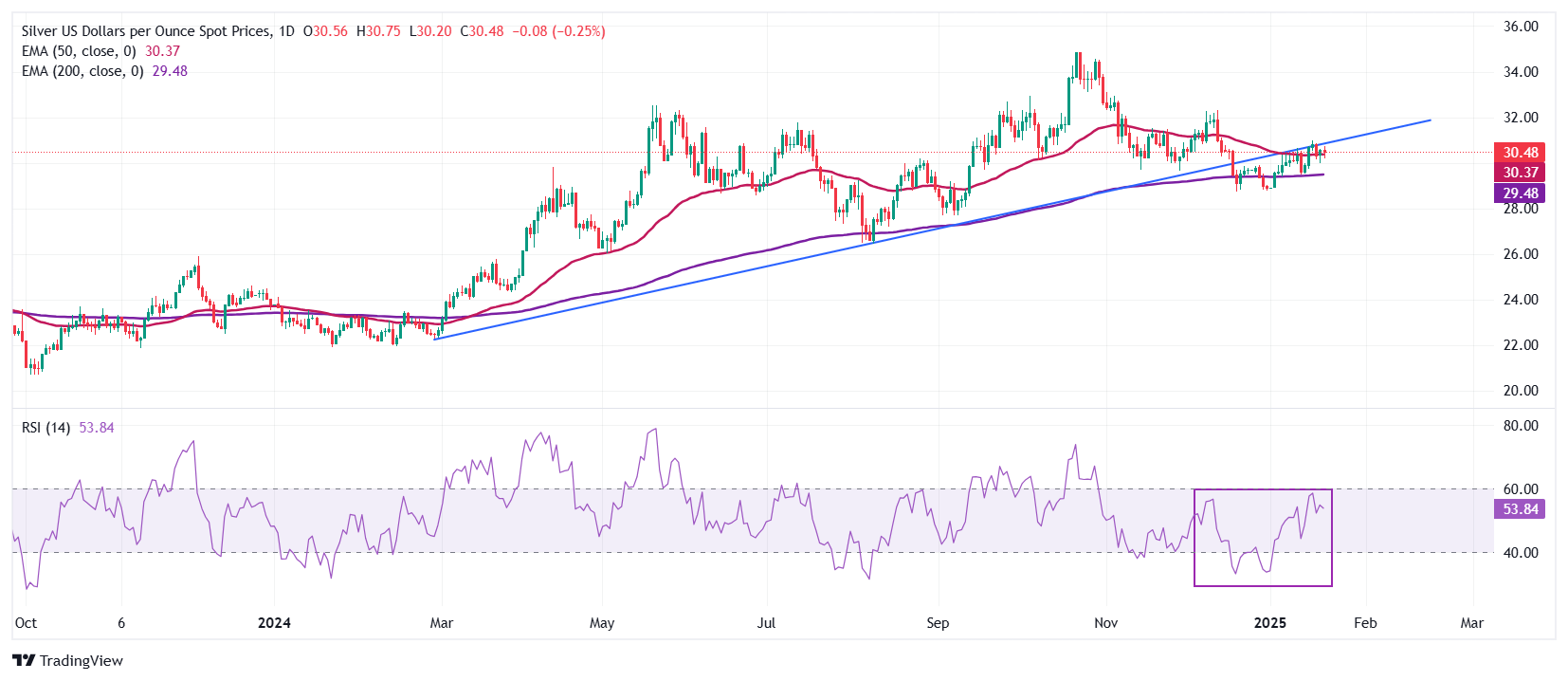Silver Price Forecast: XAG/USD trades cautiously as US Dollar rebounds with Trump’s policies in focus
- Silver price ticks lower as the US Dollar recovers sharply, with Trump keeping the tariff hike plan intact.
- Trump directed federal agencies to scrutinize trade relations with neighbors and China.
- Traders have raised dovish bets for the Fed’s May policy meeting.
Silver price (XAG/USD) drops slightly to near $30.50 in Tuesday’s European session. The white metal faces pressures as the US Dollar (USD) rebounds strongly after President Donald Trump confirmed that the plan of tariff hikes on foreign countries is delayed not denied. On his first day at the White House, Trump mentioned that the proposal of universal tariff hikes is on the table, but “We are not ready for that yet”.
The US Dollar Index (DXY), which tracks the Greenback’s value against six major currencies, rebounds sharply from its almost two-week low around 108.00, which it posted on Monday. Historically, a higher US Dollar weighs on precious metals, such as Silver, by making them expensive for investors.
The Greenback plummeted on Tuesday after reports from the Wall Street Journal (WSJ) showed that tariff hikes were absent in a presidential memo. However, the memo indicated that Trump has directed federal agencies to study trade policies and evaluate trade relationships with China and other North American economies.
Meanwhile, the downside in the Silver price has been limited by falling bond yields. Lower yields on interest-bearing assets reduce the opportunity cost of non-yielding assets, such as Silver, which improves their appeal. 10-year US Treasury yields decline to 4.56%. US Treasury yields have slumped as trader expect that the Federal Reserve (Fed) could cut interest rates in the policy meeting in May.
According to the CME FedWatch tool, the probability for the Fed to reduce interest rates in May has eased to 53% from 63% a week ago.
Silver technical analysis
Silver price struggles near the upward-sloping trendline around $30.80, which is plotted from 29 February 2024 low of $22.30 on a daily timeframe.
The white metal discovered strong buying interest near the 200-day Exponential Moving Average (EMA) around $29.45 and but struggles to sustain above the 50-day EMA, which is around $30.30.
The 14-day Relative Strength Index (RSI) faces pressure near 60.00. A fresh bullish momentum would trigger if it manages to break above 60.00.
Silver daily chart

Silver FAQs
Silver is a precious metal highly traded among investors. It has been historically used as a store of value and a medium of exchange. Although less popular than Gold, traders may turn to Silver to diversify their investment portfolio, for its intrinsic value or as a potential hedge during high-inflation periods. Investors can buy physical Silver, in coins or in bars, or trade it through vehicles such as Exchange Traded Funds, which track its price on international markets.
Silver prices can move due to a wide range of factors. Geopolitical instability or fears of a deep recession can make Silver price escalate due to its safe-haven status, although to a lesser extent than Gold's. As a yieldless asset, Silver tends to rise with lower interest rates. Its moves also depend on how the US Dollar (USD) behaves as the asset is priced in dollars (XAG/USD). A strong Dollar tends to keep the price of Silver at bay, whereas a weaker Dollar is likely to propel prices up. Other factors such as investment demand, mining supply – Silver is much more abundant than Gold – and recycling rates can also affect prices.
Silver is widely used in industry, particularly in sectors such as electronics or solar energy, as it has one of the highest electric conductivity of all metals – more than Copper and Gold. A surge in demand can increase prices, while a decline tends to lower them. Dynamics in the US, Chinese and Indian economies can also contribute to price swings: for the US and particularly China, their big industrial sectors use Silver in various processes; in India, consumers’ demand for the precious metal for jewellery also plays a key role in setting prices.
Silver prices tend to follow Gold's moves. When Gold prices rise, Silver typically follows suit, as their status as safe-haven assets is similar. The Gold/Silver ratio, which shows the number of ounces of Silver needed to equal the value of one ounce of Gold, may help to determine the relative valuation between both metals. Some investors may consider a high ratio as an indicator that Silver is undervalued, or Gold is overvalued. On the contrary, a low ratio might suggest that Gold is undervalued relative to Silver.


